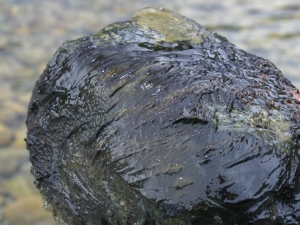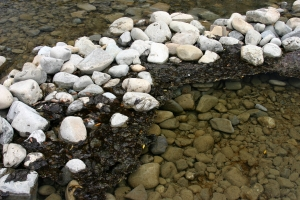During the summer months council staff keep a close watch on toxic algae levels around the region. The results for regular monitored sites can be viewed via this link:
The full brochure of toxic algae FAQ's can be downloaded:
Toxic algae in New Zealand's rivers are mostly from one species of cyanobacteria (Microcoleus autumnale, formally known as Phormidium autumnale). Cyanobacteria are an ancient group of organisms with characteristics in common with both bacteria and algae. Toxic algae is often referred to as blue-green algae, and has been known in the past as phormidium.

Image of toxic algae
Toxic algae grow on the stream bed, but mature mats can detach and flow in the water after extended low flows. While they are relatively widespread in lakes and rivers in New Zealand, they generally cover a very small percentage of the bed. They are found in a wide range of water quality conditions, including relatively 'clean' waters.
Under favourable conditions, toxic algal cells can multiply and form blooms in lakes or thick mats attached to river and stream beds.
Some species produce natural toxins called cyanotoxins which are a potential threat to people and animals if present in drinking water or if people and animals come into contact with the water during recreational activities.
The first dog death in Tasman District suspected to be due to toxic algae was recorded in 2009 in the Takaka River. All other such dog deaths were in the Waimea and Wai-iti Rivers (2012, 2013 and 2014).
Toxic algae is most prevalent in late spring to autumn in the following rivers: Waimea, Lower Wai-iti, Lower Motupiko and Lower Sherry. In these rivers it can cover over 20% of the bed surface (above Interim Guidelines). It is present many other rivers, such the Buller, Wangapeka, Motueka, and Takaka, but generally at much lower levels. They are known to be more prevalent after discharges of fine sediment.

Toxic algae mats on the rivers edge
Toxic algae mats are a dense dark green, dark brown or black colour and are typically found on stable substrate such as large rocks, stones and cobbles. These mats are soft and jelly-like to the touch, can be over 3mm thick, and spread out from a point, often completely covering a stone. These algal mats will frequently smell musty.
They may appear like 'dreadlocks' in slow moving parts of the river when they grow on tree roots. They may come loose from the riverbed and form floating 'rafts', which become caught in other debris in the river. When the toxic algae mats die and dry out they become light brown or white in colour.
Comparatively, the more brightly coloured long filamentous green algae that is common in rivers and streams is harmless and does not produce toxins.
The presence of extensive mats of toxic algae is linked with environmental conditions conducive to their growth. Favourable conditions include the right combination of warm temperatures, sunlight, low or stable river flows, nutrients and fine sediment. The occurrence of mats or algal blooms is a natural phenomenon, but human activities, such as taking water from rivers or adding nutrients or fine sediment to waterways, can make things worse.
No. They may or may not be toxic, depending upon prevailing environmental conditions. However, if potentially toxic algae are present in large numbers, you should presume that the water may be unsafe for contact recreation or consumption.
Some algae have toxins in their cells, and can be harmful if they are consumed. Such algae present a risk to dogs which may eat algal mats, or ingest algae when they drink water from a watercourse. Other toxic algae may release toxins into the water surrounding them, which can affect those that contact or drink the water.
Identification of toxic algae requires a microscope as its presence alone does not confirm cyanotoxin production. Not all species produce cyanotoxins and not all toxic species produce toxins continuously. Cyanotoxins are identified using a range of laboratory tests. The factors that trigger toxin production in toxic algae are not completely understood.
Dogs are particularly susceptible to poisoning from mat-forming toxic algae as they enjoy being in the water and can consume these mats intentionally or by accident. Livestock are also at risk from poisoning from cyanotoxins and should be provided with alternative drinking water. Symptoms of poisoning in animals include:
In extreme cases death can occur within 30 minutes after signs first appear. If you are concerned, contact a veterinarian immediately.
If you are concerned about your animals, you should contact a veterinarian immediately. You or your vet can report any animal illness resulting from contact with the toxic algae to your local council.
People can be exposed to the toxins by swallowing or drinking the water, skin contact with the water, and the consumption of fish or shellfish from affected waters. Swallowing water containing the toxins can lead to vomiting, diarrhea, abdominal pain, cramps, and nausea. Skin contact with the toxins can cause irritation of the skin, eyes, nose, and mouth, which may appear as itchiness, redness, and dermatitis.
Conditions such as asthma, hay fever, and eczema or dermatitis may also worsen. Toxins can also affect the liver and the nervous system. Those at greatest risk of a reaction are children, pregnant women, the elderly, and those with pre-existing medical conditions.
Any reaction depends on the type of cyanobacteria, the type of cyanotoxins present, and the concentration of the toxin in the water. The higher the concentration of toxic algae, its cyanotoxins and the longer contact with the water, the more severe the symptoms are likely to be.
If you think you have experienced a reaction after exposure to water containing toxic algae, see your GP and inform them that you think you have been exposed to potentially toxic algae. Ask your GP to notify Nelson-Marlborough Public Health Service of a possible toxic algae reaction.
No. Toxins are not removed by boiling, normal filter systems, or by adding household disinfectant.
Check your intake (and also upstream) for the presence of toxic algae mats and contact your local council if you think your water supply may be affected.
No. You should avoid any skin contact with the water and avoid swallowing the water. The higher the concentration of toxic algae and cyanotoxins and the longer time in the water, the more severe the symptoms are likely to be.
No. Eating mussels and other shellfish from affected areas should be avoided as they can concentrate the cyanotoxins produced by the toxic algae. If you choose to eat fish from waters containing toxic algae, you should eat them in moderation. Avoid eating the liver and kidney of the fish, as this where accumulation of cyanotoxins may be the greatest. Fish may taste earthy. Avoid contact with the water while fishing and wash all fish in clean water
How safe boating and canoeing are depends on the amount of direct contact with the water. If you swallow the water or your skin is in contact with the water while boating or canoeing, you are at risk from a reaction to any cyanotoxins that may be present. The higher the concentrations of toxic algae and cyanotoxins and the longer that people are in contact with the water, the more likely a reaction is to occur. Wash boats or canoes and life-jackets down with clean water after use
No, wearing a wetsuit will not protect you. The toxic algae may accumulate in the collar and cuff areas of wetsuit and rub against your skin. This may cause a skin reaction in these areas. If you do choose to wear a wetsuit and go into the water, take care to rinse any algae off the wetsuit with fresh water.
Yes. Fruit and vegetables do not appear to absorb the toxins. However, fruit and vegetables should be washed well in clean water as the toxic algae may form a residue on the surface, which can remain toxic even when dry.
Avoid taking water from affected areas. If you do take water, stand away from sprays to avoid contact with, or inhalation of aerosols.
Last modified: